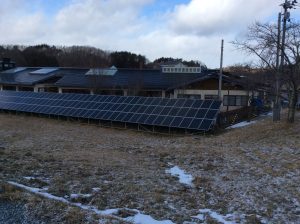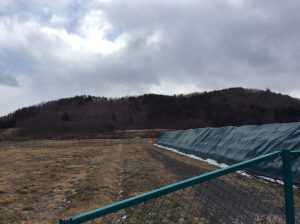On the 24th we visited the northeastern region of Fukushima prefecture, particularly the cities of Nihonmatsu and Iitate. This area had been important for rice growing and the raising of cattle, and home to some early adopters of organic farming. It was inland enough to be largely uneffected by the earthquake and tsunami components of the Triple Disaster on March 11th, 2011. Tragically, however, winds directed much of the radioactive plume from the Fukushima Daiichi Nuclear Power Plant towards this region despite it’s prior designation as an evacuation zone.

The home for elderly people, occupied to only 30% capacity.
Radiation levels are low enough today that the government has encouraged former residents to move back: whether this is wise or not remains unclear, but it seems only a minority of people have chosen to do so. The government has constructed extravagant new buildings and facilities to encourage people to return and to restore a sense of normalcy, at the same time we saw facilities such as an elementary school and a home for the elderly that were operating far below capacity.

One pile of plastic bags containing contaminated radioactive soil. The cat is visible (but very small) in the center.
Enormous piles of plastic bags rose above many fields, filled with countless tons of soil that had been scraped 5 centimeters deep off of the landscape in order to contain radioactive particles. From listening to Professor Jackson over the last two days it was clear that the beta and gamma radiation from the cesium-137 in this soil would not be contained by these plastic sheets, nor would the cesium finish decaying any decade soon. We spotted a cat among these rows of bags, and I wondered about the effects on the unknowing local animal life.

A solar sharing field growing winter vegetables. The beams are tall enough to allow a small tractor underneath.
We heard from Ouchi Osamu, an organic farmer following the footsteps of his father’s adoption of organic methods in the late 1970’s. Like many others, he said he had no real knowledge of radiation before the disaster and was unsure whether farming like normal in this area could ever resume. After the disaster he joined Kondo Kei and others of the Iitate Power Generation Company in experimenting with Solar Sharing: the partial shading of organic crops by elevated solar panels. This investment provides a sustainable source of additional income for both new and experienced farmers and seems a brilliant addition to the history of Japanese space-maximizing solutions. They described to us how—counter to our immediate intuitions—partial shading actually confers advantages to the crops and the farmer. Shade keeps the farmer more comfortable and protects the plants from the damage of excessive sunlight, and past a certain point more sun does not help the plants to grow.
For the supporters of Solar Sharing, both in the Fukushima area and in places like Tokyo, they hope that the responsible incorporation of technology and improved economic incentive will encourage the careers of new young farmers. Simultaneously, solar demonstrates a safer alternative to nuclear energy, better suited to the unpredictable and caticlismic natural disasters tied to Japan.
Recent Comments